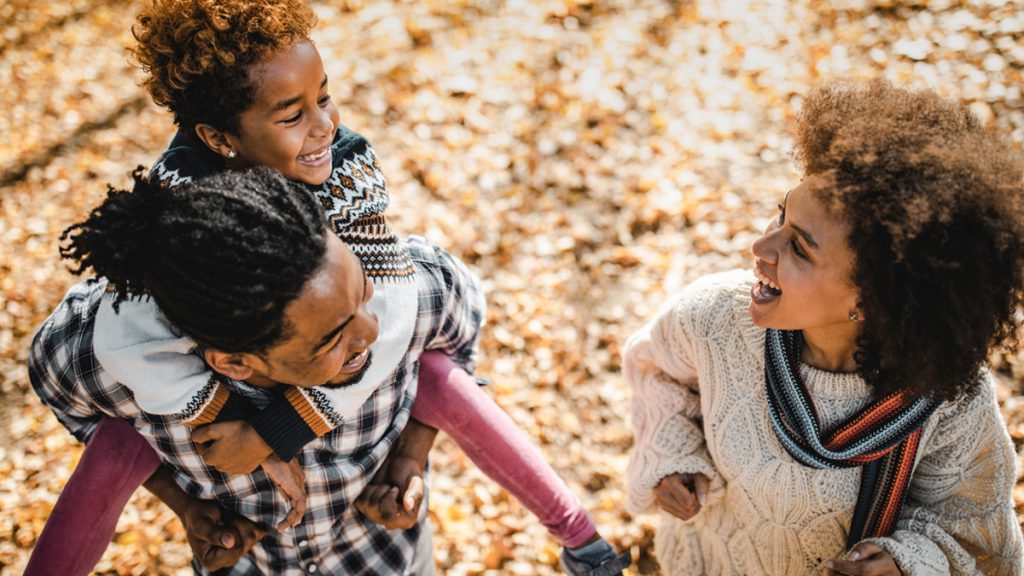
Autumn is here. Leaves are falling. A chill is in the air.
At this time of year, I set self-care intentions to guide my winter habits. I make sure to spend time relaxing on the couch with a good book, a warm blanket, and a steaming cup of tea. I also think about ways to keep my body moving every day. I find that unlike relaxing on the couch, I need to plan my movement to make sure it happens.
If you are like me, you have a child in your life and can sometimes find it hard to fit in all your priorities. I crave quality time with my daughter, and I want to spend as much time with her as I can. I also teach her about caring for herself and appreciating her body’s strengths and capacities. I realize that the example I set for her is more powerful than my words. Sometimes, this means that I get some, “me time” without her. Other times, we find ways to exercise together. It looks different on different days. Sometimes, we kick around a soccer ball or throw a Frisbee. Other days we have dance parties in the kitchen. As her eyes light up, I realize that my own face reflects the same delight.
Many of my best conversations with my child happen during our walks. The weather is not always ideal, and sometimes it takes convincing to get her to come with me; however, once we are outside, something changes. We really connect when it is just the two of us, away from screens, toys and other distractions of home. When we are out walking with her small hand in my own larger one, I am thankful for her company and the chance to move together.
I described how activities done together might promote bonding between caregiver and child. This is a powerful motivator. We know that this is one of a plethora of reasons for families to move together.
Find your why. If you choose to set goals for yourself, let them be unique to you. My motivation is prevention, so I use weights to build my bone density, run to strengthen my heart muscle and do yoga for both flexibility and mental health. What motivates you to move?
Try something new. What interests your child? What activities are appropriate for their developmental stage? Talk with your doctor before beginning exercise. They can help you determine what activities are right for you.
Thank your body. Our bodies do so much for us. We can appreciate their support and teach children to do the same. Ask children what movements their bodies like to make and tell their bodies thank you for making that motion to extend an arm to wave across the playground or use a foot to kick a soccer ball.
There are so many ways to do it. Each person approaches physical movement from their own unique place. What do you love to do? What type of movement feels comfortable for your body? What works in the space of your home or your community? What changes for you in various seasons? Build resilience by modeling trying something new, pushing yourself while maintaining healthy boundaries and finding something fun.
Bring baby with you. Movement may require more creativity when caring for an infant. What gear do you have that supports movement? Could you wear your baby or push her in a stroller while going for a walk? Could you stretch or dance while he is sleeping?
Here is one family exercise idea for each letter of the alphabet — afterschool hopscotch, bouncing on a trampoline, community classes, duck, duck, goose, epic dance-off, Frisbee, gymnastics, hula hooping, inline skating, jumping rope, kicking a ball, lifting weights, martial arts, nature hiking, outdoor time, playing catch, quick game of basketball, running, stretching, tag, unicycle riding (or bicycle or tricycle), videos on YouTube, walking, xtra housework, yoga, Zumba.
The benefits of physical activity, per the American Academy of Pediatrics, are:
- Helps prevent obesity, heart disease and diabetes.
- Helps students focus in school.
- For teens, helps avoid risk-taking behaviors like smoking, drinking and using drugs.
- Improves sleep.
- Burns calories.
- Strengthens the cardiovascular system.
- Builds strong bones and muscles.
- Increases flexibility.
- Diffuses stress.
- Teaches teamwork and sportsmanship.
- Boosts self-esteem.
- Improves an overall sense of well-being.
Resources
6 Frugal Ways to Exercise With Young Kids
10 Tips to Get Kids To Exercise
Making Physical Activity a Way of Life: AAP Policy Explained
Sesame Street: Get on Up and Move!
This article is from Family Support News Brief’s November 2020 edition. The Family Support News Brief covers topics like Parents as Teachers model fidelity and training, strengthening families protective factors, prevention of child abuse, childhood injury prevention, and more.
